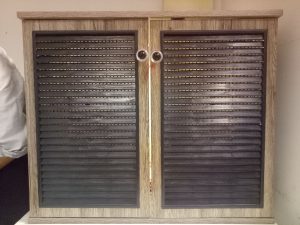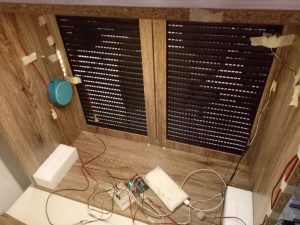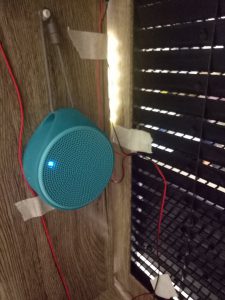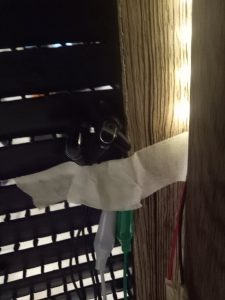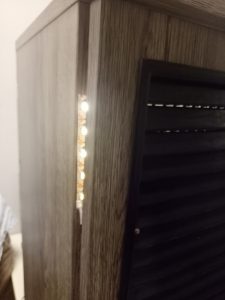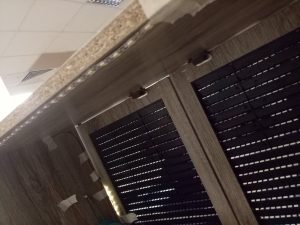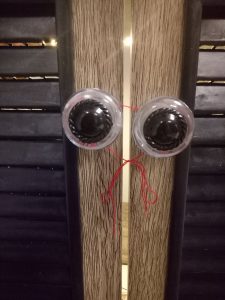“Are you trying to understand?”
When we listen to stories, we only listen to one side of the story. But often we fail to recognize this, and taking everything face value, thinking that what we heard is the fact instead of just a side to the story. Even worse – often we realize that, yet we don’t try to find out the truth. We make ourselves content with what we know. We overlook that lack of understanding, although we know it is there.
Based on the theme of “interstice of understanding”, we created project Door.
Group members: Dan Ning and Vania
Materials / Components
- Cabinet (pre-bought and self-arranged)
- Laptop
- Power bank
- Bluetooth speaker
- Earphone
- Arduino UNO
- Breadboard
- LED strips
- Photoresistors
About the Narrative
Recordings were played using bluetooth speaker and earphones at two different points.
Since the theme that we explored revolves around “understanding”, we thought it’s apt to convey that using a narrative. We wrote down dialogues and split them into several parts of recordings after settling down on a base plot and characters.
In a nutshell, our story is a reverse Cinderella story – we used a base story that is familiar with most people. We all know that in the Disney version of the story, Cinderella was abused by her stepmother and her two stepsisters. Eventually, with the help of a fairy godmother, she managed to get a life she finally deserved.
In our narrative, we simply ask a question: What if Cinderella was never abused, but it’s just what people thought happened?
Through the dialogue, we conveyed the idea that Cinderella actually helped out due to her own will, to the point that people suspected she was being forced to work. In actuality, Cinderella got along with her stepmother and stepsisters well. We gave the stepsisters more personality by giving them two different perspective; one of them was very fond of Cinderella, yet scared to step out and actually tell the people off; another one didn’t exactly hate Cinderella, but not fond of her because she felt that Cinderella’s presence made their family suffer. She also grew to be upset towards her own sister (the other stepsister) as her sister didn’t say anything against the people.
If you listened to the recordings, you will realize the similarities and differences of the perspectives among the characters – who strongly opposed the people’s accusation, who hated the people, who hated Cinderella, who blamed themselves.
A final recording revealed that actually the people’s accusation came from Cinderella’s grandmother. She bore hatred towards the stepmother as she felt that she took everything away – her son (Cinderella’s father) and Cinderella. She didn’t spread the words just to abuse the stepmother, but rather because she truly believed that the stepmother was in the wrong. She thought she was saving Cinderella by doing so – which, as the other recordings suggested, was not the case.
Basically, the whole narrative showed multiple perspectives. Through this, we wanted to compel people to think critically of everything they heard.
List of the recordings:
Behind the Scenes
At first, we planned to use 2 Arduinos: one for the main components (photoresistors and LED strips) and one for the background components (PIR and background LED strips).
How they work
The main components will allow the LED strips to be turned off when someone comes near it, and light up under normal condition. It is to attract people to come to the right spots (near the speaker and earphone) so people don’t need to search the source of sound blindly. We used photoresistors as the sensor, so when light is blocked by the presence of someone, the lights will go off.
The background components will allow motion to be detected using the PIR. When someone comes close to the cabinet, the background light will go off to focus attention to the holes where the LED strips for the spots are located. When someone opens the cabinet door, a final recording will play, stopping all the subsequent recordings (which will be played at random between the two sources of sound).
Change of plans
The PIR worked at first; however when we were coding and trying things out, the PIR suddenly just wouldn’t detect motions, although it was fine before. Since it was nearing the deadline, we decided to just scrap the PIR out and used external power supply (power bank) to light up the background LED strip. Because of this, we can’t let people open the cabinet, so to indicate that the cabinet is not to be opened, we tied a string on the handle. But conceptually, it can be a good analogy: how much effort are you going to put to find out the truth? Is a simple string going to stop you?
How it goes
Since our project is contained within a cabinet, it was easy to move it around.
After we installed our components into the cabinet, however, suddenly one of the photoresistors refuse to work. So we had to present with one of them not working, but afterwards, we solved the problem; we put a wrong value for the brightness setting in the code because the conditions are slightly different. Since the photoresistors were not working when we presented, it was hard to determine where the sources of sound were.
We constantly played the recordings on loop, but not loud enough for people to hear. It compelled people to come closer and put their ears right by the cabinet in order to be able to hear, so in a sense, it can only be used by one person at a moment. However I wouldn’t say that this is an individual experience, since although you “interact” with it individually, you can ask around on what other people hear and combine your stories to find out the truth. That, again, refers to the idea of how much effort are you going to put?
Characteristics
Level of interactivity
I think the feedback is more interactive since as soon as you approach the cabinet, there is a clear and immediate action that happened, which is the LED strips lights going out due to the change detected by photoresistors. It is visible even to people who are not interacting with it at that time.
The automation in our project is also not very high; the automated feedback that is set is only the photoresistor-LED light. We’re supposed to have the PIR and background light as well, but it didn’t work and because of that, I think the automation falls more to the passive rather than interactive side. There is still a certain amount of audience control as we used LED lights to guide them to where the speakers are exactly, navigating them to approach those spots instead of wandering around.
I also think there is an indirect collaboration to this project, in the sense that you can “exchange” the recordings that you heard with other people to reveal the actual story. But then again, this collaboration depends heavily on the audience, and may not necessarily happen.
About the adaptivity, I think our project doesn’t really possess automated adaptivity. It doesn’t possess memory that can provide feedback through continuous interactions, which will allow different actions to happen to counter whatever weakness was encountered throughout previous interactions.
The communications in this project is also very one-sided, since people can only listen to the recordings without responding back. This project doesn’t really have an identity or personalization, but rather more just like a platform that is different from usual, which allows people to “overhear” a conversation.
Characteristics of the interface
Firstly, it is kind of separated from real world experience since in order to interact with the project fully (that is, to listen carefully to the recordings), you will have to concentrate fully to the cabinet at that time or you will miss the sounds from the recordings since they are very soft. However, even after that the experience still may continue by exchanging the recordings with other audience, and that one will involve more real-world experience. That was our intention; to mimic the story to a real-world story so people can discuss about it outside the actual physical interaction with the cabinet, bringing it even to the real world.
The interaction is also intuitive, as the recordings would be played in a continuous loop. People will subconsciously be compelled to find out what the sounds are about, and they would go to the spots where the LED lights are turned on, where they can hear the sounds clearer. They can also tell intuitively that they’re not supposed to open since the handle is tied with strings. There is also a certain degree of subtlety as all the components is being contained in the cabinet where people can’t see them.
(That one refers to our final project that was presented, which scrapped the idea of revealing of final recording after opening the cabinet. But in case we did it and the cabinet could be opened, we would cover the components with wood anyway.)
However, the experience wasn’t monitored and used to provide feedback in the future; the installation has no memory. The experience is going to be the same no matter how many times people come to it; in a sense, the audience acts more like an observer. There is no selection at all and the experience is mostly linear; the only randomness comes from how we randomize the order of the recordings played, but in the end, they’re all the same recordings.
Conclusion
Individual parts
Dan Ning: main coding, research for material, doing the recordings, troubleshooter, physical installation
Vania: helping with the coding, main writer for the narrative/dialogue, editing the recordings, physical installation
Reflection
I think one biggest weakness that we didn’t solve is how to attract people enough to stay and listen to all the recordings. Moreover, we looped them at random, which means after the final recording, the other recordings will just start playing again immediately – there is nothing that distinguish the most important final recording from the others.
At first, the connections between the wires weren’t very secure since we used crocodile clips and taped them using masking tape, but then we switched to jumper wires.
I think we’re trying too hard to achieve something that is conceptually interesting instead of getting our basics down first, which resulted in a lot of problem in the coding process since both of us are not that well-versed in programming to begin with.
One of the biggest problem Dan Ning encountered was the setting of the sources of sound. We initially wanted to use more sources, but there were problems with the coding. Moreover, the USB speakers were not working, so we had to use bluetooth speaker and earphones – the experience when listening using both of them are vastly different, and she had to program the volume every time we set it up.
We were also kind of worried about the recordings since we asked our friends to do those, and they might not be able to convey the proper emotions (they’re not actresses, after all), but I think it turned out fine.
I think another problem that we have is that we don’t have backup plans; a lot of our things failed at the last minute, and we didn’t have spare components or backups, so we have to settle for something else (i.e. the bluetooth speaker and earphones instead of USB speakers, not using PIR since it didn’t work)
All in all, we encountered a lot of troubles. For me, this personally reminds me not to do things last minute (I do that a lot). We also learned to always have spares and back up plans, no matter how minute the problem may seem. Overall, besides learning more about coding and installation, we also learn more about group work and the importance of setting up specific deadlines for each person, so there won’t be any last minute things.
